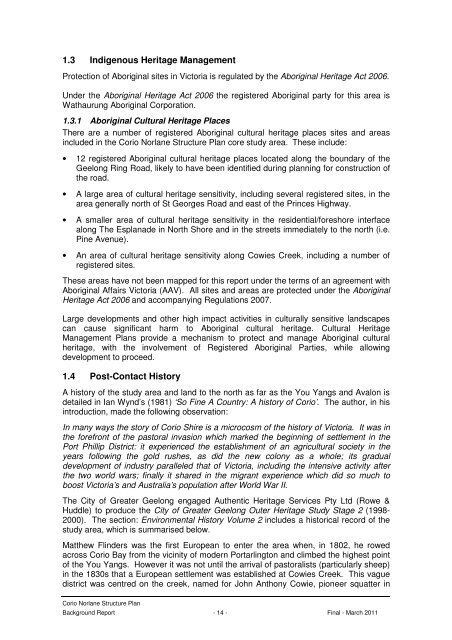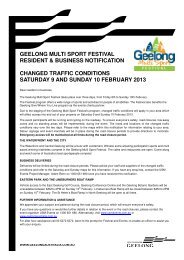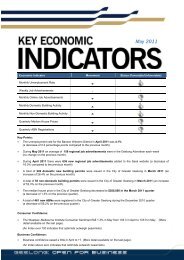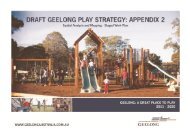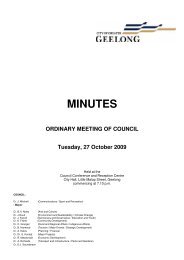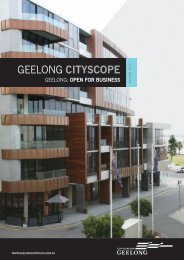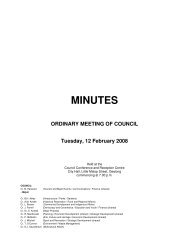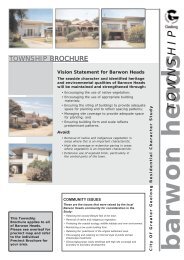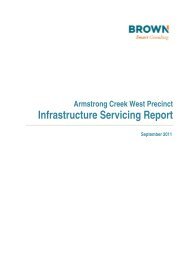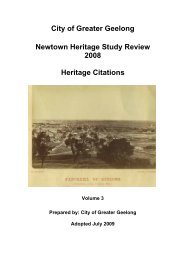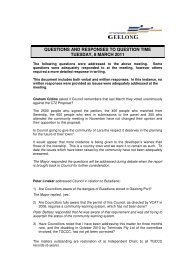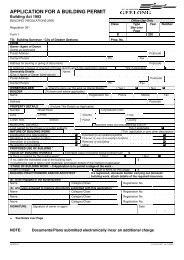corio norlane structure plan background report - City of Greater ...
corio norlane structure plan background report - City of Greater ...
corio norlane structure plan background report - City of Greater ...
Create successful ePaper yourself
Turn your PDF publications into a flip-book with our unique Google optimized e-Paper software.
1.3 Indigenous Heritage Management<br />
Protection <strong>of</strong> Aboriginal sites in Victoria is regulated by the Aboriginal Heritage Act 2006.<br />
Under the Aboriginal Heritage Act 2006 the registered Aboriginal party for this area is<br />
Wathaurung Aboriginal Corporation.<br />
1.3.1 Aboriginal Cultural Heritage Places<br />
There are a number <strong>of</strong> registered Aboriginal cultural heritage places sites and areas<br />
included in the Corio Norlane Structure Plan core study area. These include:<br />
• 12 registered Aboriginal cultural heritage places located along the boundary <strong>of</strong> the<br />
Geelong Ring Road, likely to have been identified during <strong>plan</strong>ning for construction <strong>of</strong><br />
the road.<br />
• A large area <strong>of</strong> cultural heritage sensitivity, including several registered sites, in the<br />
area generally north <strong>of</strong> St Georges Road and east <strong>of</strong> the Princes Highway.<br />
• A smaller area <strong>of</strong> cultural heritage sensitivity in the residential/foreshore interface<br />
along The Es<strong>plan</strong>ade in North Shore and in the streets immediately to the north (i.e.<br />
Pine Avenue).<br />
• An area <strong>of</strong> cultural heritage sensitivity along Cowies Creek, including a number <strong>of</strong><br />
registered sites.<br />
These areas have not been mapped for this <strong>report</strong> under the terms <strong>of</strong> an agreement with<br />
Aboriginal Affairs Victoria (AAV). All sites and areas are protected under the Aboriginal<br />
Heritage Act 2006 and accompanying Regulations 2007.<br />
Large developments and other high impact activities in culturally sensitive landscapes<br />
can cause significant harm to Aboriginal cultural heritage. Cultural Heritage<br />
Management Plans provide a mechanism to protect and manage Aboriginal cultural<br />
heritage, with the involvement <strong>of</strong> Registered Aboriginal Parties, while allowing<br />
development to proceed.<br />
1.4 Post-Contact History<br />
A history <strong>of</strong> the study area and land to the north as far as the You Yangs and Avalon is<br />
detailed in Ian Wynd’s (1981) ‘So Fine A Country: A history <strong>of</strong> Corio’. The author, in his<br />
introduction, made the following observation:<br />
In many ways the story <strong>of</strong> Corio Shire is a microcosm <strong>of</strong> the history <strong>of</strong> Victoria. It was in<br />
the forefront <strong>of</strong> the pastoral invasion which marked the beginning <strong>of</strong> settlement in the<br />
Port Phillip District: it experienced the establishment <strong>of</strong> an agricultural society in the<br />
years following the gold rushes, as did the new colony as a whole; its gradual<br />
development <strong>of</strong> industry paralleled that <strong>of</strong> Victoria, including the intensive activity after<br />
the two world wars; finally it shared in the migrant experience which did so much to<br />
boost Victoria’s and Australia’s population after World War II.<br />
The <strong>City</strong> <strong>of</strong> <strong>Greater</strong> Geelong engaged Authentic Heritage Services Pty Ltd (Rowe &<br />
Huddle) to produce the <strong>City</strong> <strong>of</strong> <strong>Greater</strong> Geelong Outer Heritage Study Stage 2 (1998-<br />
2000). The section: Environmental History Volume 2 includes a historical record <strong>of</strong> the<br />
study area, which is summarised below.<br />
Matthew Flinders was the first European to enter the area when, in 1802, he rowed<br />
across Corio Bay from the vicinity <strong>of</strong> modern Portarlington and climbed the highest point<br />
<strong>of</strong> the You Yangs. However it was not until the arrival <strong>of</strong> pastoralists (particularly sheep)<br />
in the 1830s that a European settlement was established at Cowies Creek. This vague<br />
district was centred on the creek, named for John Anthony Cowie, pioneer squatter in<br />
Corio Norlane Structure Plan<br />
Background Report - 14 - Final - March 2011


